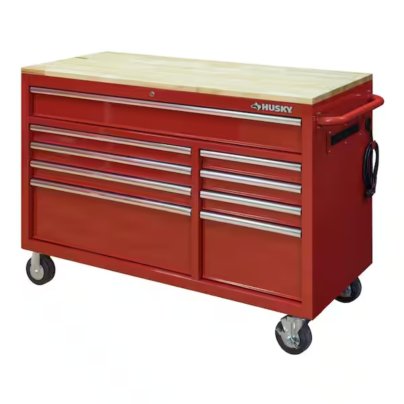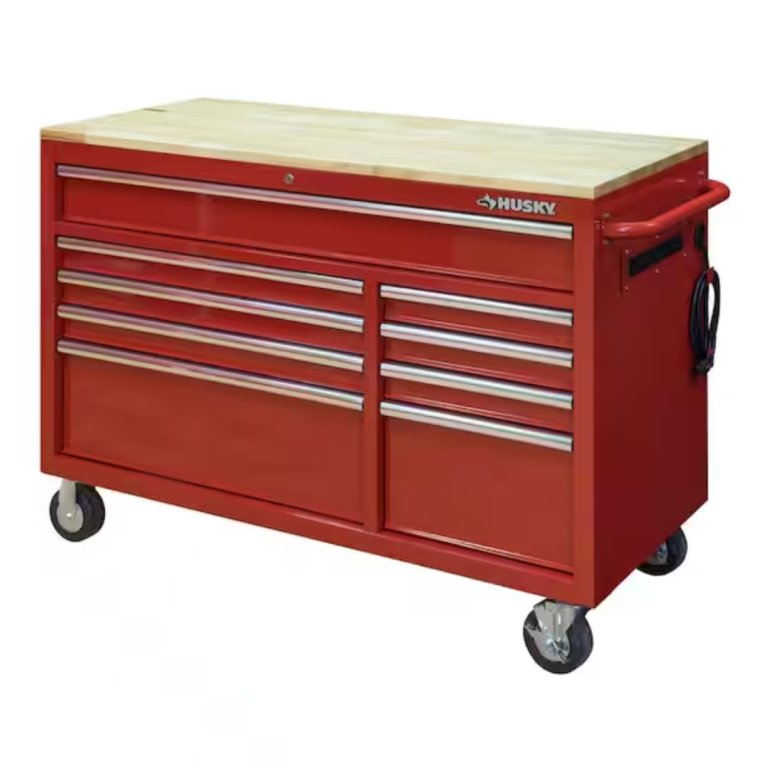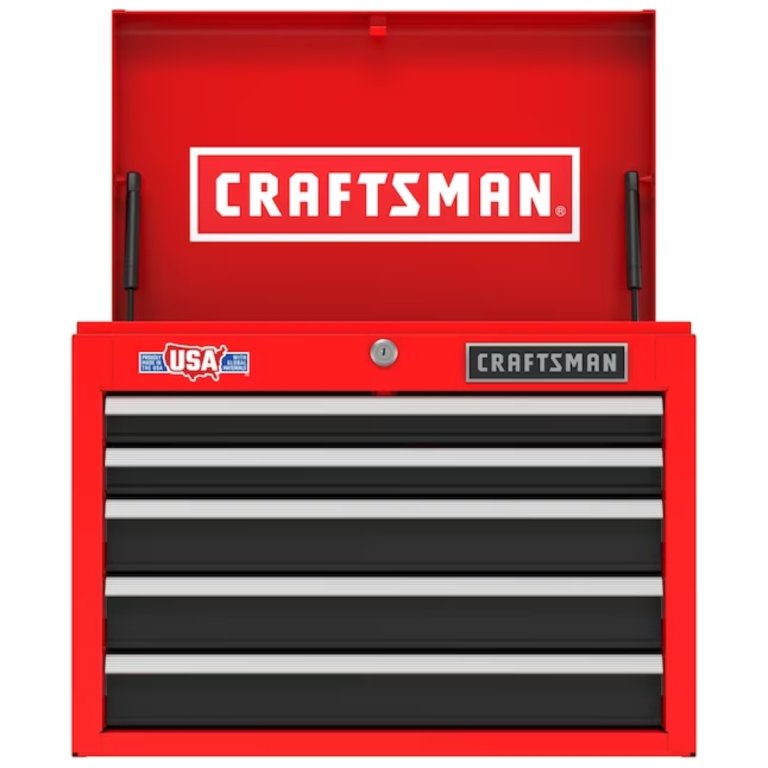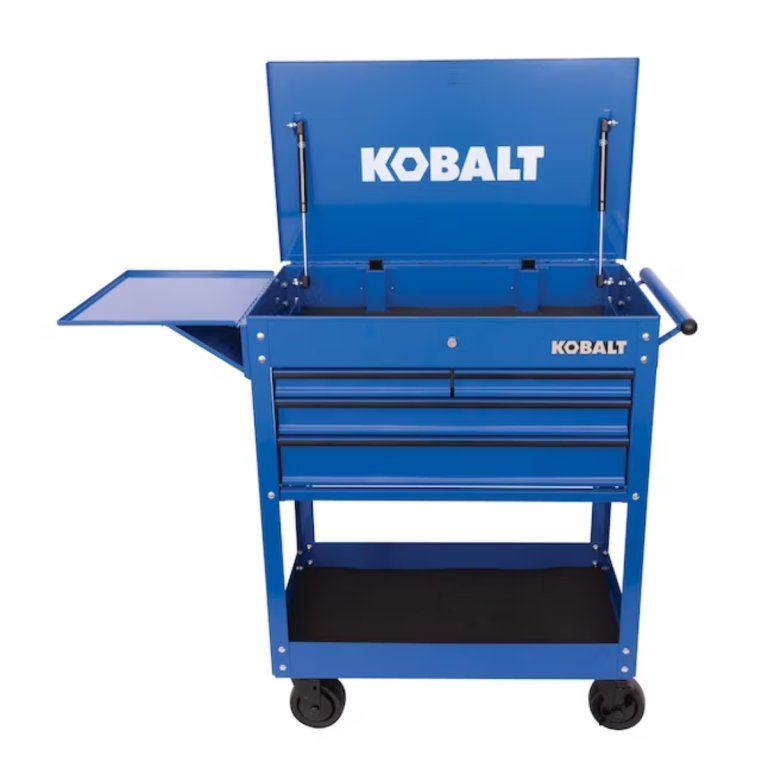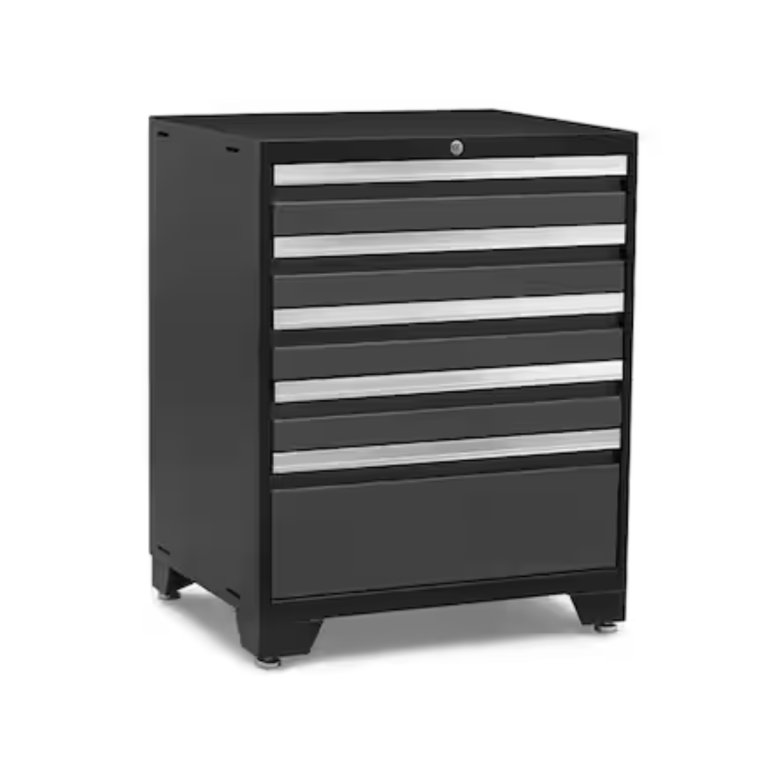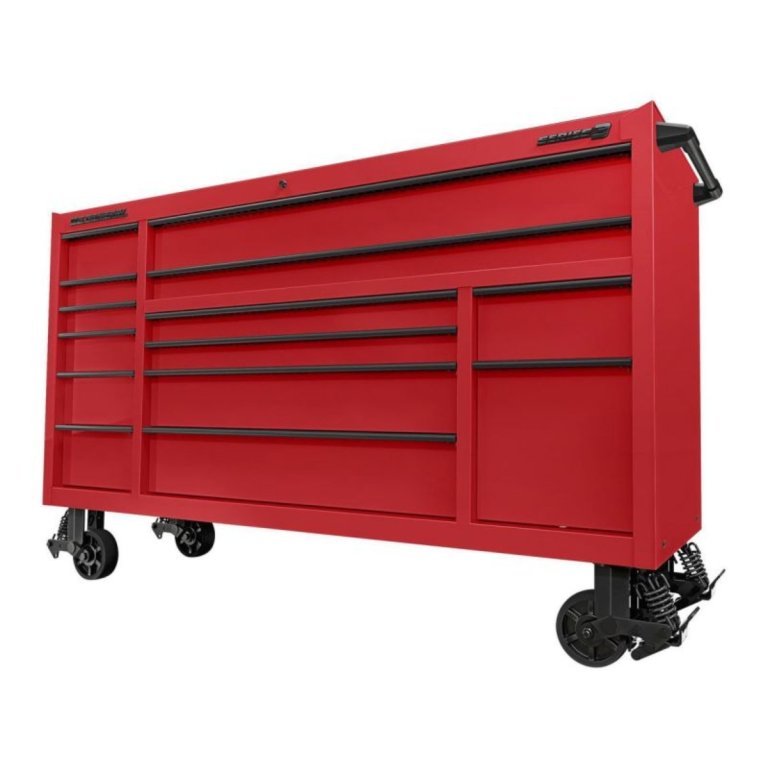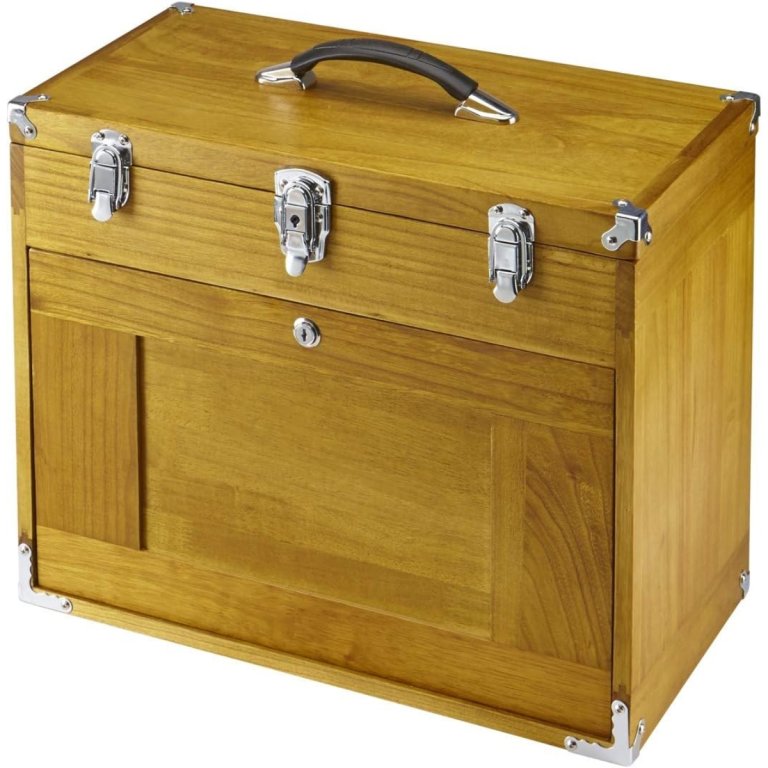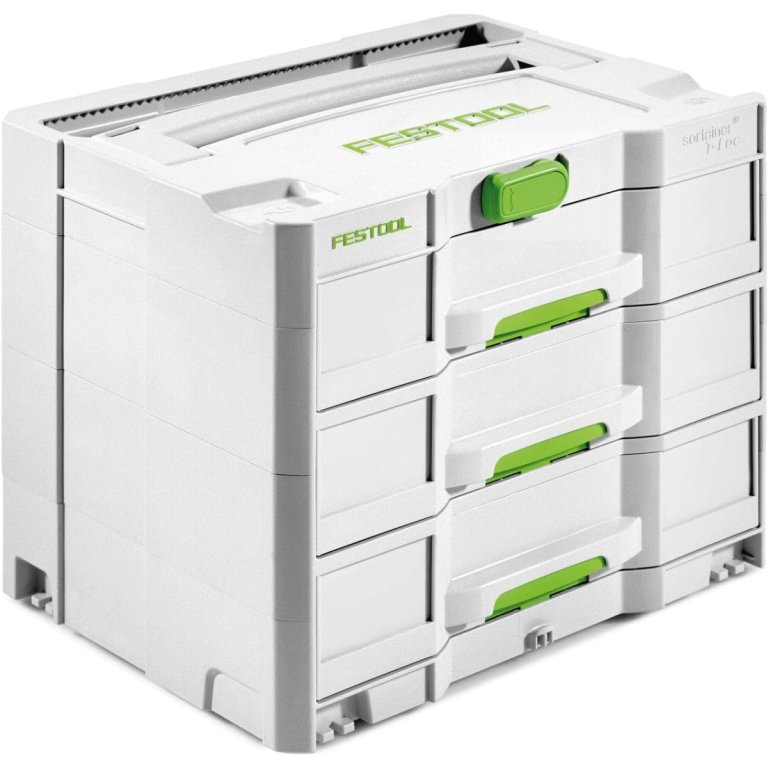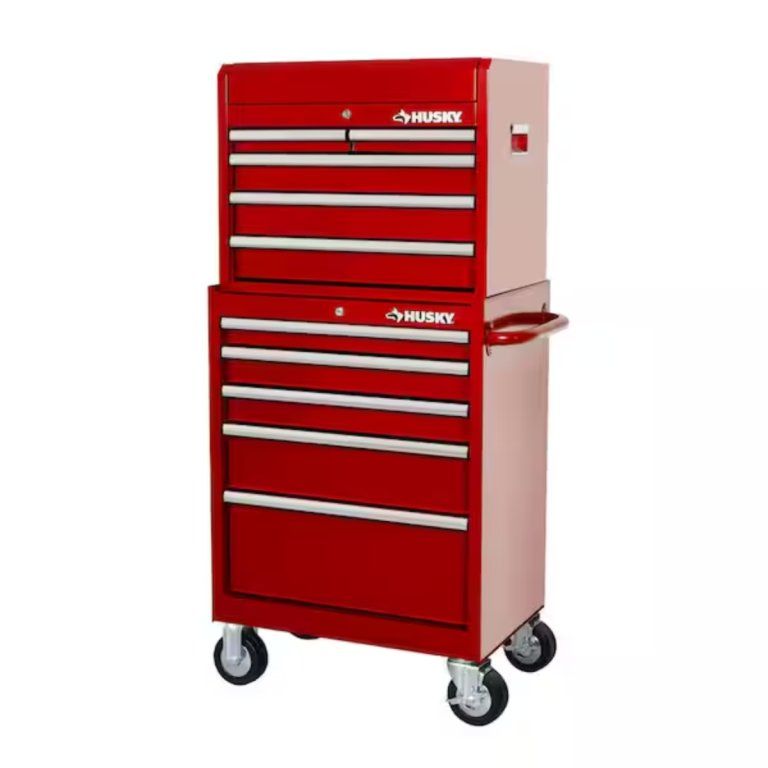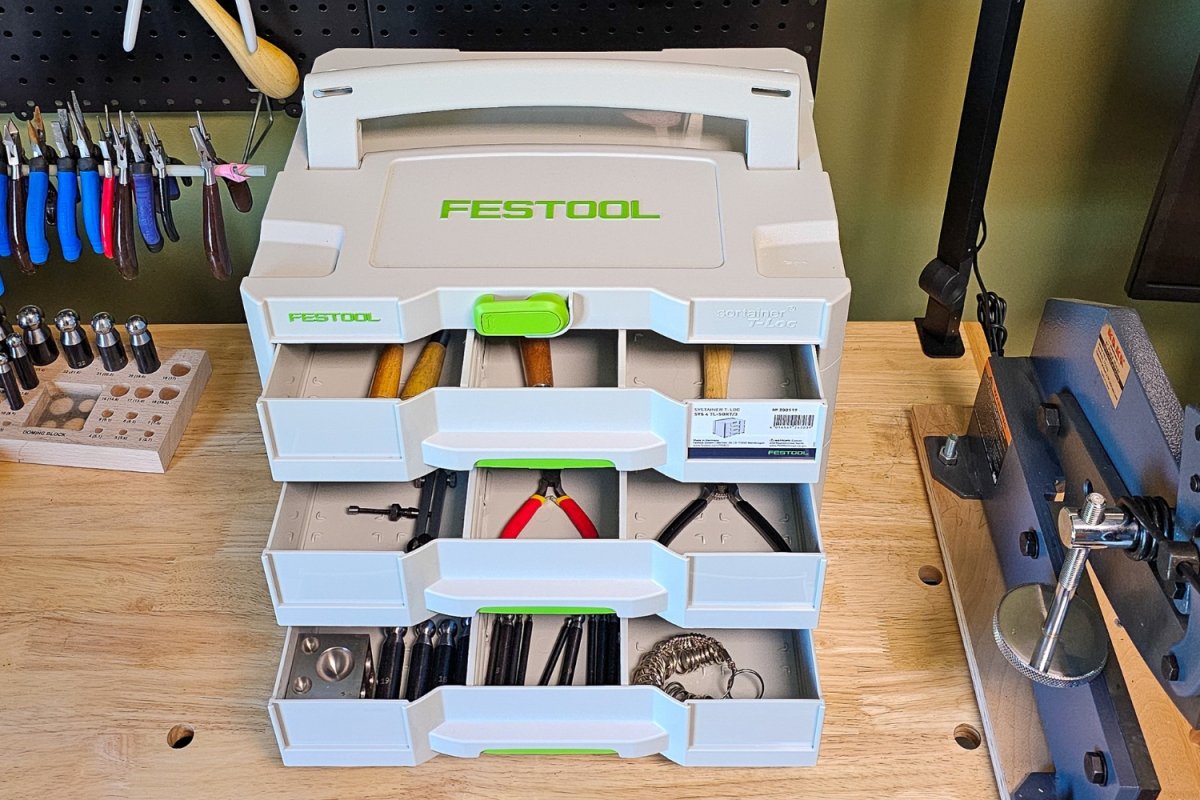
We may earn revenue from the products available on this page and participate in affiliate programs. Learn More ›
Tool chests offer a straightforward solution for organizing and storing small tools and accessories. Our test team tried out today’s most popular tool chests, scrutinizing everything from build quality to organizational design, and ultimately, a few winners rose to the top. Our favorite of the bunch, the Husky Standard Duty 9-Drawer Mobile Workbench Cabinet, offers a winning combination of rugged construction, butter-smooth drawer slides, and versatile storage options.
But the Husky tool chest is far from the only winning model in our tests. Whether you’re looking to organize a collection of screwdrivers, sockets, or router bits, you’ll find a tool chest that suits your needs on our list. Keep reading to learn about important considerations when shopping for the best gear storage, and find out how the following models earned a spot on our lineup of the best tool chests on the market today.
- BEST OVERALL: Husky Standard Duty 9-Drawer Mobile Workbench Cabinet
↓ Jump to Review - BEST BANG FOR THE BUCK: Craftsman S2000 5-Drawer Metal Tool Chest
↓ Jump to Review - BEST ENTRY-LEVEL: Kobalt 4-Drawer Steel Rolling Tool Cabinet
↓ Jump to Review - BEST ORGANIZATION: NewAge Pro Series 5-Drawer Tool Cabinet
↓ Jump to Review - BEST MULTIPURPOSE: U.S. General Series 3 Roll Cab Tool Chest
↓ Jump to Review - BEST WOOD: Windsor Design 8-Drawer Wood Tool Chest
↓ Jump to Review - BEST PLASTIC: Festool SYS 4 Sortainer Tool Chest
↓ Jump to Review - BEST NARROW BUILD: Husky 10-Drawer Tool Chest and Cabinet Combo
↓ Jump to Review
How We Tested the Best Tool Chests
The right tool organizer for one user might not be right for another, so we set out to test models in various sizes with different options at diverse price points. We considered the brand to an extent; after all, manufacturers such as Husky and Craftsman have sterling reputations in the industry. We also looked closely at the relative newcomer, NewAge Products, which is making a big splash in high-quality storage and outdoor entertainment products.
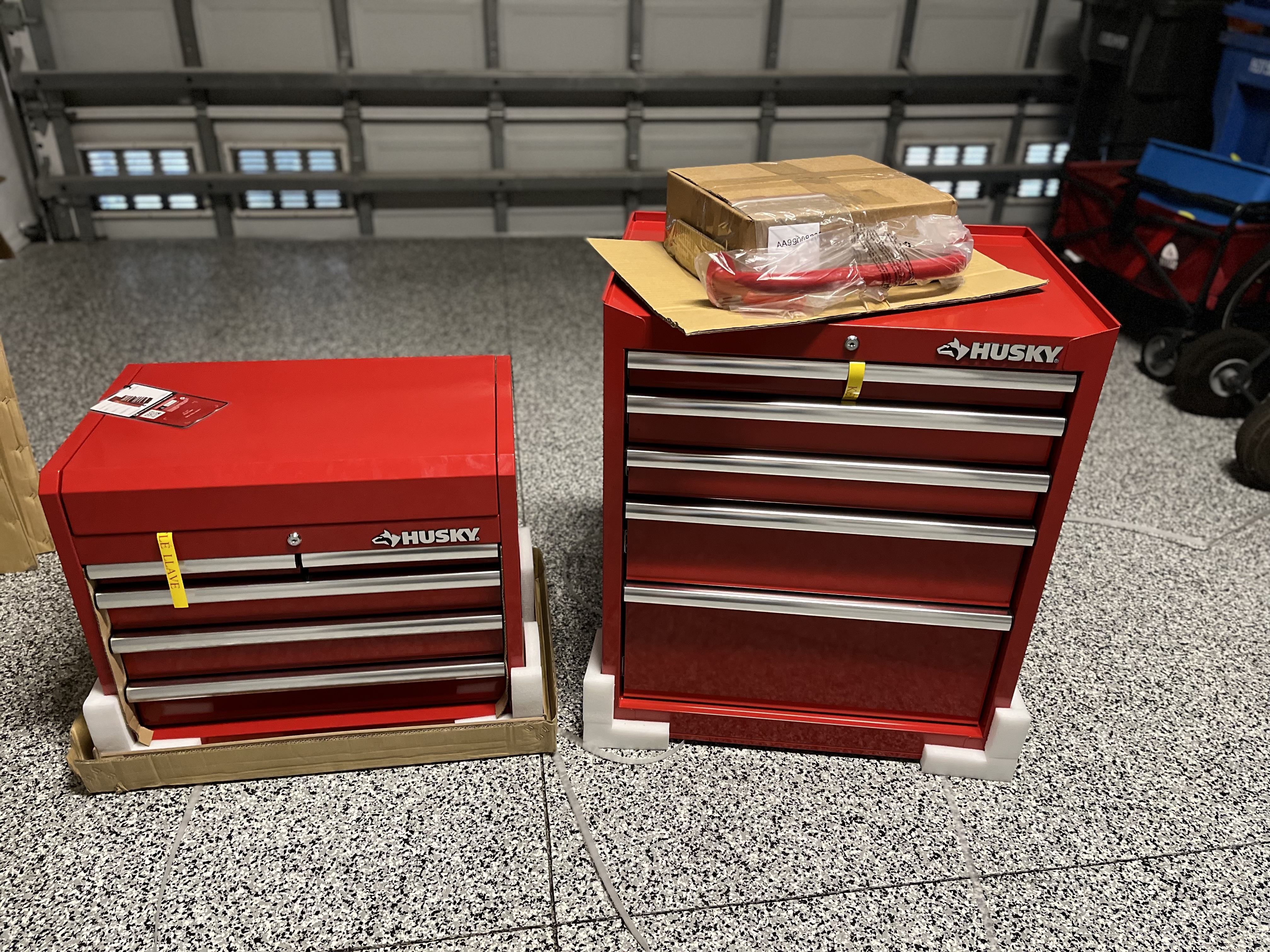
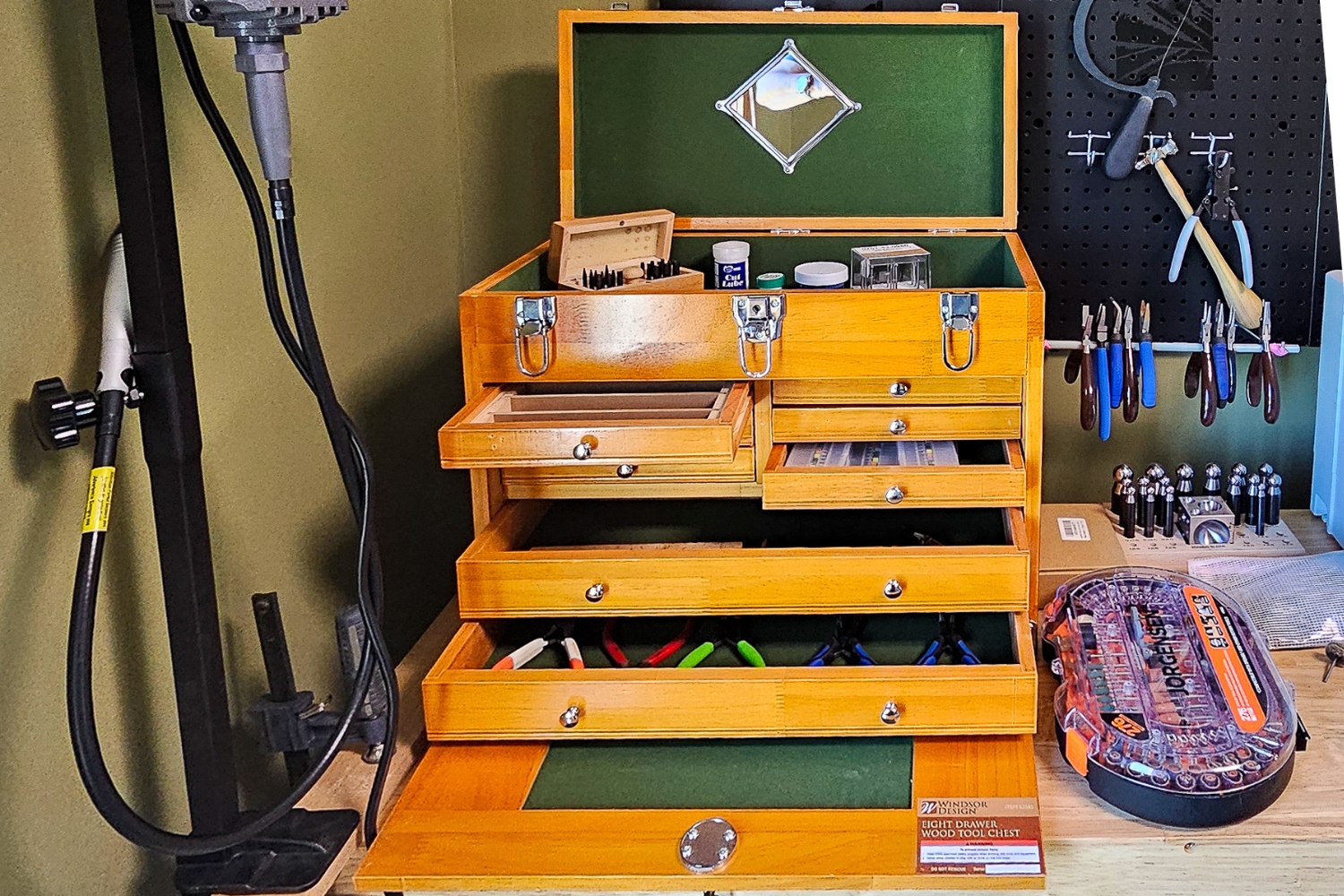
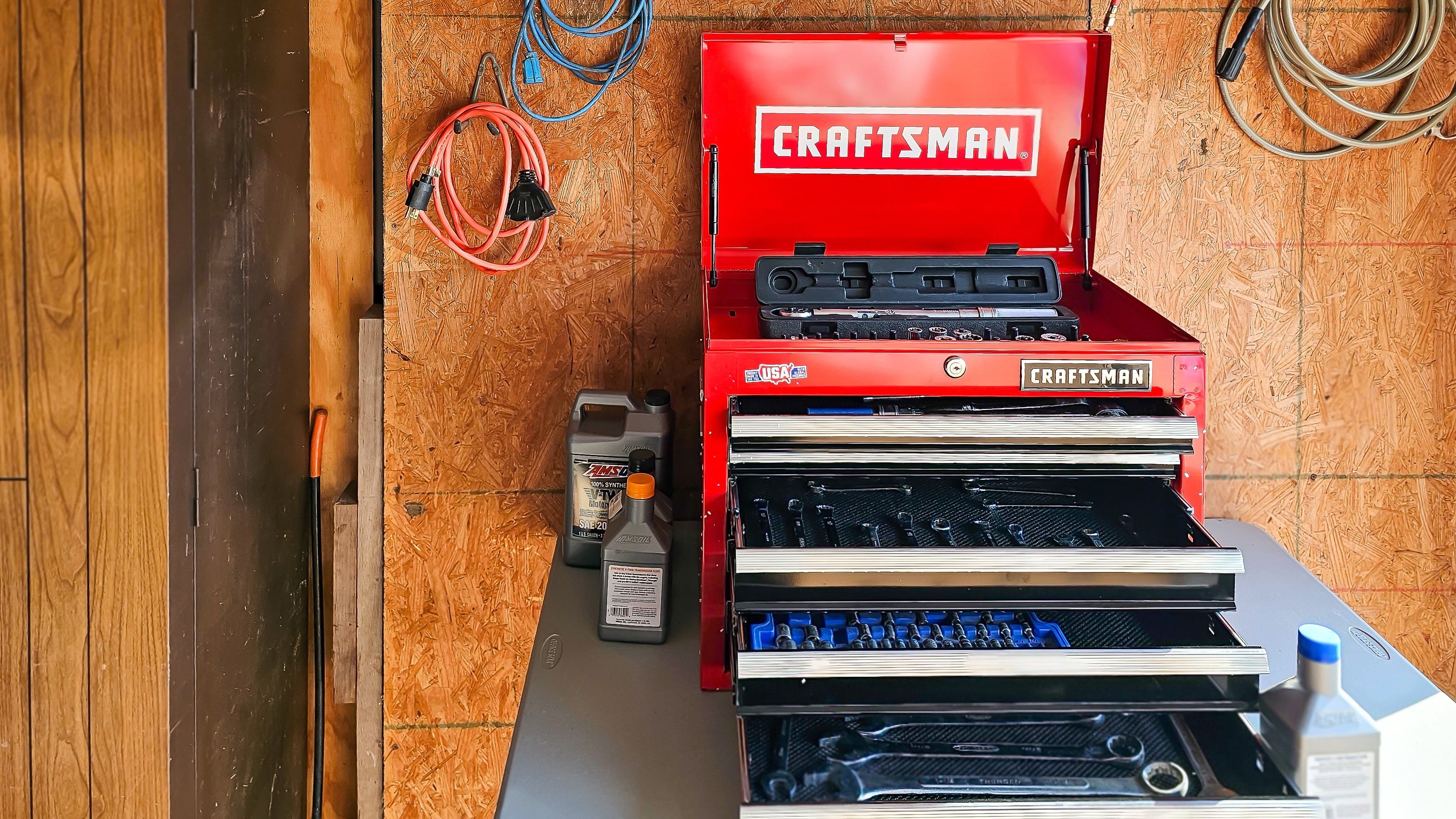
In actual testing, we noted whether assembly was required and, if so, how clear the instructions were. Then, we examined and tested every tool chest organizer, assessing each one’s design, portability, security, and how much weight the drawers would hold. We assigned points based on a rubric; the better a tool chest performed, the higher the points. After testing, we averaged the points to find our best overall pick and determine the best categories for the other chests.
| Testing Stats | |
| Products tested | 8 |
| Time spent testing | 1 week |
| Tests performed | 4 |
| Price range | $150 to $1,000 |
Our Top Picks
Each of the following tool chests earned a spot on our list based on the results of our hands-on tests and assessments. Size, weight, mobility, storage capacity, and cost vary from one model to another, but one of the picks on our lineup is sure to meet your tool-storage requirements.
Best Overall
Husky Standard Duty 9-Drawer Mobile Workbench Cabinet
What We Like
- Packed with useful design features, such as a wood workbench top
- Offered in a variety of colors, drawer configurations, and steel thicknesses
- Comes mostly assembled; minimal setup required
What We Don’t Like
- Heavy, but handle and casters make it easy to move
Product Specs
- Compartments: 9
- Dimensions: 38 inches high by 52 inches wide by 24.5 inches deep
- Locking drawers: Yes
- Weight capacity: 1,500 pounds
Our Ratings: Assembly 5/5; Organization 5/5; Build Quality 5/5; Portability 4.5/5; Value 5/5
At 267 pounds, this nine-drawer Husky workbench cabinet made from 21-gauge steel is a beautiful beast. It’s packed with features, including a solid wood worktop, built-in power strip, and soft-close locking drawers. None of the drawers have an organization system, but no dividers are necessary given the attached (but removable) padded grippy liners that hold loose tools in place while protecting against scratches and dents.
Assembling this Husky was quick and easy—all we had to do was attach the wheels, handle, and cord keeper. The only part of the setup that took any real time was adding all our tools. While we don’t have a totally comprehensive set of tools for our home, we have all the basics. Everything we wanted to store fit nicely, including a circular saw, jigsaw, screw organizer, variety of hand tools, T square, and a large cutting mat.
Because this workstation has a side handle and large caster wheels, we were able to move it around during testing, even when full. The locking wheels held nicely when we pushed against the unit, though we’d be nervous about them holding this heavy chest on a hill. For general shed or garage spaces, however, its six built-in outlets and two USB-A ports make it an ideal option for mobile project work. Though inconsequential to its operation, we also love its beautiful finish and trim. Upon seeing it, our 17-year-old daughter (who couldn’t care less about tools) said, “When I came home and saw that, it instantly made me happier!”
Get the Husky 9-drawer tool chest at The Home Depot or Amazon.
Best Bang for the Buck
Craftsman S2000 5-Drawer Metal Tool Chest
What We Like
- Well made from 18-20 gauge steel
- Chest can be used on its own or as a topper
- Rated to hold up to 650 pounds of weight
- Affordably priced yet high quality
What We Don’t Like
- Slightly misaligned lid made opening and closing the top tricky
Product Specs
- Compartments: 5
- Dimensions: 23 inches high by 19 inches wide by 29 inches deep
- Locking drawers: Yes
- Weight capacity: 650 pounds
Our Ratings: Assembly 5/5; Organization 5/5; Build Quality 4.5/5; Portability 4/5; Value 5/5
You don’t have to spend a lot to get a high-quality tool chest to stow and protect your tools and accessories. This five-drawer model from Craftsman’s S2000 series offers ample room for storing a collection of sockets and other small tools. It has a double-wall steel construction, and its dimensions are well suited to storing various tools.
We placed it on a table because, with its 23-inch height, we felt it would be too much trouble to bend and retrieve tools from the lowest drawers if it were positioned on the floor. If desired, users can order another tool chest and set this upper model on top, but it works just as well when placed on a bench or table.
This handy Craftsman chest features a keyed lock on the upper front as well as two easy-grip handles built into the sides to facilitate relocation. Although it’s smaller than some of the other garage cabinets in our tests, it’s not wimpy. It weighs a beefy 72 pounds when empty, so it won’t be easy to carry when filled with tools.
We filled this compact mechanic tool chest with as many tools as we could, and the drawers still slid smoothly. We did run into one issue: The chest arrived with the lift-open top slightly misaligned, which caused the lid to hang when opening and closing it. The problem wasn’t insurmountable, though. We found we could push the lid to the left to open and close it. It could have gotten misaligned during packaging or shipping, but it didn’t diminish our feelings about the quality of the Craftsman. This is a great, affordable tool chest.
Get the Craftsman tool chest at Lowe’s.
Best Entry-level
Kobalt 4-Drawer Steel Rolling Tool Cabinet
What We Like
- 6 colors to choose from
- Good for most people with a standard set of tools
- All casters rotate 360 degrees
What We Don’t Like
- Not ideal for heavy-duty or professional use
- No self-closing drawers
Product Specs
- Compartments: 4 drawers, top chest, bottom tray
- Dimensions: 37.5 inches high by 35 inches wide by 17.75 inches deep
- Locking drawers: Yes
- Weight capacity: 550 pounds
Our Ratings: Assembly 3/5; Organization 5/5; Build Quality 4.5/5; Portability 4.5/5; Value 4.5/5
The Kobalt tool chest is not only nice to look at—it’s also packed with features any homeowner or DIYer would need to store a standard set of tools. And compared to other models we tested, we loved this chest’s ease of portability.
While we wouldn’t consider its 94-pound frame heavy duty, it can hold up to 550 pounds and feels fairly lightweight when being rolled around the garage. The drop leaf and multiple screwdriver storage holes on the exterior were a pleasant surprise, as they provide extra workspace and access to your most used screwdriver set without having to unlock the chest.
When testing the drawers, we quickly realized that adding heavier tools can cause the chest to become top-heavy and tip when the bottom shelf is empty. This can be prevented by organizing tools according to weight, keeping the heaviest on the bottom.
We did experience a hiccup during installation because the instructions didn’t clarify if the holes in the legs should be closer to the top or bottom (the correct answer is the top). After that trial and error, it was fairly easy to put together.
Mike Illig, a builder and business owner from Ebensburg, Pennsylvania, who has more than 60 years of building experience and has used several different tool chests over the years, was impressed with its portability. “It’s not common for all four casters to rotate completely. The Kobalt is easy to move in all directions and a good height for a workspace. You’re getting a nice tool chest for the money.”
Get the Kobalt tool chest at Lowe’s.
Best Organization
NewAge Pro Series 5-Drawer Tool Cabinet
What We Like
- Great for custom tool box organization
- Made from solid materials; can last a lifetime
- Drawers operate smoothly, even with heavy loads
- Soft padded liners in each drawer keep everything in its place
What We Don’t Like
- Very heavy and difficult to move around (attachable wheels sold separately)
Product Specs
- Compartments: 5 drawers
- Dimensions: 32.3 to 37.1 inches high (adjustable) by 28 inches wide by 22 inches deep
- Locking drawers: Yes
- Weight capacity: 1,000 pounds
Our Ratings: Assembly 5/5; Organization 5/5; Build Quality 5/5; Portability 2/5; Value 4.8/5
The first thing we noticed about the NewAge cabinet was how heavy it was. Made from 18-gauge double-walled steel and weighing 172.8 pounds, this waist-height cabinet was difficult to unbox and move around since there are no wheels (although caster wheels can be purchased separately and added on if desired). Once we got it into place, though, the features started to shine through.
This tool cabinet has four standard drawers and one large drawer at the bottom. Each opened and closed with a silky smooth motion, and all of them featured a soft lining to prevent tools from banging and sliding around.
The standout feature of this tool box was the adjustable dividers you can use to customize each drawer to fit exactly what you want to store inside it. With eight vertical and eight horizontal dividers, these were more than enough to create our own perfect storage spaces in each of the four standard drawers. If you tend to hold on to an assortment of small items in your workshop and wish you could find them easily, the organizational power of this tool cabinet might just be exactly what you’re looking for (it certainly was for us).
Get the NewAge tool chest at The Home Depot or NewAge.
Best Multipurpose
U.S. General Series 3 Roll Cab Tool Chest
What We Like
- Heavy-duty construction
- Ball-bearing drawer slides
- Functional drawer configuration
What We Don’t Like
- Only 2 of the casters swivel
- Electrical strip mounted inside
- Plastic drawer tends to catch
Product Specs
- Compartments: 8
- Dimensions: 43.75 inches high by 56.75 inches wide by 22 inches deep
- Locking drawers: Yes
- Weight capacity: 4,400 pounds
Our Ratings: Assembly 5/5; Organization 5/5; Build Quality 5/5; Portability 4/5; Value 4.8/5
Whether you’re a professional or you just have an abundance of tools, this steel-frame tool box from U.S. General will not disappoint. It’s big but arrives completely assembled, and it has two locking swivel casters, which made it fairly easy for us to move it around the garage.
It also features two stationary casters that provide some added security against rolling on uneven surfaces. We tested the eight drawers by adding weights and were impressed with how smoothly they opened and how much they were able to hold. The soft-close mechanism, full-extension ball-bearing slides, and locking latches are features we generally only see on high-end tool chests.
There is a charging drawer with a built-in power strip (including USB-C outlets!) for charging multiple batteries simultaneously. The deep drawer holds multiple drills and power tools, and the other drawers are just the right size to organize an entire collection of small and large tools.
Illig, who also helped test the Kobalt model, has used many tool chests over the years. After testing the U.S. General model, he determined that this tool chest would be ideal for a pro. “This is a professional-grade chest. I wish all four casters swiveled, but the heavy-duty drawers and frame are enough to make this a solid tool chest. I’m surprised that it isn’t more expensive.”
Get the U.S. General tool chest at Harbor Freight.
Best Wood
Windsor Design 8-Drawer Wood Tool Chest
What We Like
- Made from real wood
- Keyed latch and lock for security
- Handle makes it easy to carry
- Lined drawers protect items and keep them in place
What We Don’t Like
- Drawers do not have slides or stops, so they come right out when pulled
Product Specs
- Compartments: 9
- Dimensions: 16 inches high by 20 inches wide by 11 inches deep
- Locking drawers: Yes
- Weight capacity: 100 pounds
Our Ratings: Assembly 5/5; Organization 4/5; Build Quality 4/5; Portability 5/5; Value 4.8/5
This compact wooden chest would be right at home on a bench in a woodworker’s shop or even in a hobby room. It’s designed to hold and organize small items, such as bits for rotary tools and accessories. We tested it in our silversmithing shop to separate different gauges of wire, gemstones, and forging supplies. The felt-lined drawers were perfect for the stones since they kept them from rolling around or getting scratched.
This is a semi-rustic-style chest, so the drawers don’t come with slides or stops to keep them from falling out of the chest. We found this to be both a pro and a con. Since the drawers are small, it can be helpful to pull one out and carry it to where you’re working on a project. The downside is that it takes a little finagling to get the drawer back in its spot.
The Windsor tool chest has a couple of additional nice features, including a lift-open top that reveals an upper bin for holding larger items, as well as a tilt-and-slide front panel that can be folded up when the drawers are closed and locked in place to restrict access to the drawer contents. Overall, it’s an impressive little tool box organizer.
Get the Windsor tool chest at Amazon or Harbor Freight.
Best Plastic
Festool SYS 4 Sortainer Tool Chest
What We Like
- Well sized to place on top of a workbench
- Good for holding smaller tools and supplies
- Secure latches hold drawers shut; useful while carrying
- Durable heavy-duty plastic
What We Don’t Like
- Despite its robust construction, pricey for a plastic chest
Product Specs
- Compartments: 9 (3 drawers, 3 compartments per drawer)
- Dimensions: 12.5 inches high by 15.5 inches wide by 11.5 inches deep
- Locking drawers: No
- Weight capacity: Not listed
Our Ratings: Assembly 5/5; Organization 4/5; Build Quality 4.8/5; Portability 5/5; Value 4.5/5
Who says plastic can’t be robust and durable? The Festool SYS 4 Sortainer is an excellent choice for storing and organizing smaller tools and fasteners. Its three large drawers have adjustable dividers to accommodate many tools. We admit we were skeptical before this tool chest arrived. We envisioned a sort of flimsy container that wouldn’t hold much, but we were wrong.
This Festool chest is only one of many mix-and-match components the company makes for storing and organizing. Thanks to its modular design, it can be connected to other Festool units or used as a stand-alone chest. While it doesn’t have a locking mechanism, each drawer has a latch that engages when the drawer is fully closed. To see how well the latches held the drawers shut, we filled them with tools, closed them, and then shook the chest upside down. None of the drawers opened.
This Festool Sortainer has a useful carrying handle, and the manufacturer also sells a tool chest roller cart users can purchase if they’d rather roll than carry. Combine the unit with other pieces of the Festool system to create a personalized and expandable tool storage cabinet to fit changing needs.
Get the Festool tool chest at Amazon.
Best Narrow Build
Husky 10-Drawer Tool Chest and Cabinet Combo
What We Like
- Very portable thanks to large caster wheels and handle
- Variety in drawer sizing accommodates tools of many sizes
- Soft-closing drawers and padded liners add a quality feel
What We Don’t Like
- Questionable durability of the hard plastic caster wheels
Product Specs
- Compartments: 10 drawers and 1 shelf
- Dimensions: 58.3 inches high by 27 inches wide by 18.1 inches deep
- Locking drawers: Yes
- Weight capacity: 1,500 pounds
Our Ratings: Assembly 5/5; Organization 4/5; Build Quality 4.6/5; Portability 4.5/5; Value 5/5
For those with limited garage space but many tools to store, this option from Husky may be ideal. It has 10 drawers ranging in size to suit different tools and other items, each rated to hold up to 100 pounds. In our tests, we appreciated the soft closing mechanism of the drawers, as well as the included padded liners that were precut and slid in nicely during setup. The entire two-piece tool chest came almost completely assembled, too, which was a plus. We just needed to install the four large caster wheels on the bottom, plus the handle on the side. Easy peasy.
For testing, we overloaded the drawers above their rated 100 pounds. Even with very heavy items inside, the drawers seemed to hold up nicely, and we noticed little change to the smooth opening and closing. The bright red coating also makes quite the statement, although shoppers can opt for more subtle blue or glossy gray options, which are almost identical save for one additional drawer.
Our one gripe with the Husky was its hard plastic caster wheels. Even with both brakes applied, they didn’t seem able to fully stop the tool chest from moving when we pulled on it. This tool box on wheels just started sliding across the floor. We would have liked to have seen a hard rubberized wheel with a little more grip.
Get the Husky 10-drawer tool chest at The Home Depot.
Jump to Our Top Picks

What to Consider When Choosing a Tool Chest
Looking at the types of tool chests available is a good starting point. To refine your search, you’ll want to examine the structure in more detail. This will provide greater focus to help pinpoint the best storage option for a range of different users.
Size, Capacity, and Weight
Most people don’t have an excess of unused space in their workshop, so the physical size of the tool chest is a crucial consideration. Pictures can be misleading, so be sure to refer to the product dimensions provided by the manufacturer. One common mistake—particularly in small, cramped workshops—is failure to leave sufficient space for tool chest drawers and doors to open. Mobile tool chests seem like a great idea, but in a workshop that already has, for example, a workbench and fixed machinery like a table saw, there may not actually be room to maneuver it. Consider making a quick mock-up of the floor space the chest needs to make sure it works with the existing stationary equipment.
Capacity is equally important. Generally speaking, the greater the capacity, the more the chest will weigh. It might make a large, rolling tool chest difficult to manage despite having wheels. In some cases, it may be better to buy two smaller tool chests—one stationary and one rolling—rather than a single large one.
Drawers and Shelving
Multiple-drawer tool storage is what sets tool chests apart from tool boxes, bags, and belts. Drawers provide a convenient place to arrange tools for easy access and protect them from workshop grime. The drawers of the best tool chests often have ball-bearing slides for smooth opening and closing.
Make sure to check the dimensions: Does the drawer provide enough room for all the tools? Does the workshop provide enough space to open the drawer fully? Also, be sure that the drawer handles are easy to grasp but not so large and prominent that they get in the way.
Shelving comes in handy for storing power tools and other large items that won’t fit in drawers. Tool chests sometimes include adjustable shelves. While most tool chest designs place shelves in the lower half, some might also have an open box at the top. This is handy for switching between tools frequently.
Material
Wooden tool chests vary from small bench-top models to large freestanding cabinets. They offer plenty of versatility and, oftentimes, superb craftsmanship. Perhaps unsurprisingly, woodworkers, artists, and other fine craftspeople often prefer wooden chests. However, they do require a degree of care and wouldn’t be considered “heavy-duty” tool chests.
Plastic tool chests are affordable and offer a wide variety of choices. Most oils and chemicals found in the workshop pose no threat to plastic surfaces and wipe off easily. While more common in portable tool boxes, plastic also makes a number of tough tool chests. But not all plastic is tough—some will withstand the rigors of the workshop or jobsite, while other plastics only withstand light-duty DIY uses.
Large tool chests fixed into truck beds often use aluminum, but this material seldom finds its way into workshop tool chests. Steel—heavier, considerably stronger, and less expensive—makes up most metal tool chests. While they may rust, steel tool chests usually come painted or powder coated, which prevents this problem.
A tool chest with a comprehensive locking mechanism helps keep tools from being stolen. Although a portable metal tool box or a plastic chest may also come with locks, these typically offer limited protection.
Types of Tool Chests
The tool chest market includes designs that make organizing tools simple for anyone, including DIYers, home mechanics, woodworkers, and welders. Tool chests come in all kinds of shapes, sizes, and materials. They offer space for hand tools, power tools, and accessories. The challenge in picking the best tool chest is striking the right balance between storage, portability, durability, and price. The following sections may help you better understand the differences between product types.
Stationary
If a tool chest is designed to stay in one place, it can be larger and hold much more than one that needs to move around. Generally speaking, stationary tool chests are constructed with steel for added strength and durability, but be sure to check the thickness of the material in the manufacturer’s specifications. Just because the product description says “heavy duty” doesn’t necessarily mean it is.
Those who need lots of space for bulky tools might want to consider stationary garage cabinets. They’re a spacious and flexible storage solution that can be combined with a workbench.
Rolling
Compact and portable, a rolling tool bag can be great for small projects. If you want something a bit bigger, look for the best rolling tool box you can find, as these offer additional stability and capacity. However, if you need something bigger, rolling tool chests can hold even more tools and equipment and can be moved easily around the workshop or garage.
Rolling tool chests come in numerous designs, from two-wheeled models that maximize mobility to the tall four-wheeled tool roller chests with multiple drawers that many mechanics prefer. Some include large open areas at the base for power tools or other bulky items. They may also have convenient removable top sections that can travel to a jobsite. A larger rolling tool box will often include a useful bar across the side to help push it around.
It’s important to consider the wheels. Small flimsy ones may not support the full weight of the tool chest when filled to capacity, and a collapse could be disastrous. Plastic might be OK for lightweight tool chests, but steel casters with rubber or synthetic wheels offer better support. Foot-operated brake levers on the wheels help ensure the chest doesn’t move until needed.
Wall-Mounted
Wall-mounted tool chests can help you make the most of limited space. Typically positioned above a workbench, they keep tools readily available for the tasks performed there, which is much more convenient than storing tools beneath the bench.
Though convenient and easily accessible, wall-mounted cabinets do not provide as much storage and organization as their floor-standing counterparts. Often, they’ll offer just a shelf or two. But that makes sense, as having lots of small tools at or above eye level is rarely convenient. That said, several models offer more versatility. Some are specifically designed for cordless power-tool storage. Others include small drawers for screws, electrical connectors, or other small tool kits. They make great choices for modelers or other hobbyists.
Key considerations include the chest’s maximum weight capacity and the material and condition of the wall on which it will hang. Look for a load rating. It may also be necessary to source appropriate wall anchors separately.
Multipurpose
Multipurpose tool chests rank among the best tool chests for their versatility. Those that double as a stool, for example, don’t just provide a spot for the weary worker to take five—they also provide a convenient working platform for some tasks. These chests usually have wheels to make them easy to move around. Important characteristics are the seat material (which needs to withstand workshop treatment) and the weight capacity.
Workstations, which incorporate tool storage with a workbench, come in many shapes and sizes. Some have drawers or cabinets underneath a basic work surface; others have backboards for hanging tools or configuring other storage systems. Some remain stationary; others include locking wheels that move when needed or stay put when needed.
FAQs
Before making a final selection, check out the answers to some common questions about the best tool chests.
There are no hard and fast rules, but in general, it’s better to have heavier tools at the bottom to stabilize the chest. That aside, think about the tools you use most often—they probably need to be near the top.
EVA foam liners and/or sectional dividers and tool racks can help keep tools organized and in their place. You can also buy sheets of thicker foam, which you can then cut out to form custom-fit tool holders and dividers.
First, never put tools away dirty. This introduces moisture to the space and can contaminate other items. Take a clean rag and some light machine oil to the metal parts of hand tools that might rust before you put them away. Do not use silicon spray, which is sticky and can trap dirt. Silica gel packs are a good way to absorb moisture within the tool chest. They are widely available, small, and inexpensive. Add a few to each section.
A chest tool box should be kept in a garage or workshop unless specifically designed to weather the elements. Some mechanics will pull a wheeled tool chest out to the driveway while working on a car, but most models are not designed to withstand rain, blowing dust, or snow, all of which could get in the drawers and damage the tools.
Meet the Testers
Glenda Taylor is a contractor, product tester, and writer focusing primarily on construction and DIY tools.
Paul Rankin is a Scotland native now living in New York City. He started writing for BobVila.com 3 years ago, focusing on buyer’s guides for the full range of tools, furniture, DIY supplies, and home and garden products that the Bob Vila team reviews. He has also worked in the translation and localization industry for the past 10 years.
Kara Illig is a senior commerce editor and co-owner of a property management company. She’s passionate about finding value and efficiency in tools and home products.
Michelle Larson is an editor and writer who loves product testing so she can invest in a quality item once rather than buy something subpar twice.
Additional research provided by Timothy Dale and Bob Beacham.
